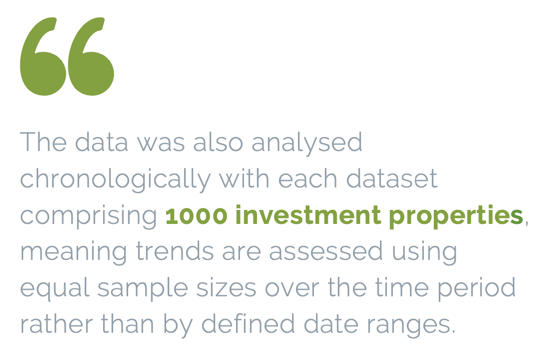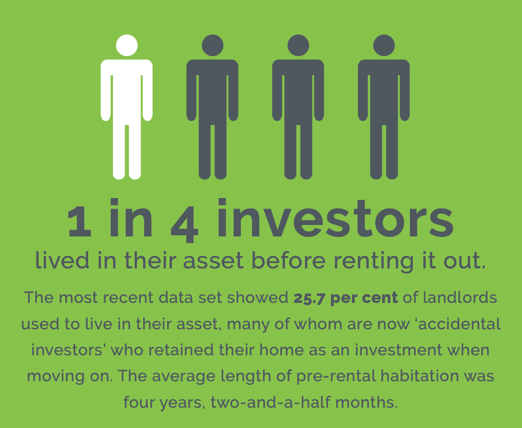This week I finally managed to coordinate my industry friend, Mike Mortlock to join me on a quick zoom interview. Mike is a Quantity Surveyor and runs a national tax depreciation business, and aside from being a numbers guru, his self-depricating jokes and quick humour make him one of my favourite ‘think-on-their-feet’ presenters.
So when I railroaded him with two minute’s notice for a recorded zoom call, he rose to the challenge.

Mike decided a little while ago to distill his QS, (Quantity Surveying) data into a 1000 Assets study 2020; a four year study on Australian investor behaviour. He captured not a few valuable pieces of data, but many, and I have to admit that I found it hard to choose just one to interview him on.

I decided on an interesting fact: just over one in four landlords have lived in their investment property. From my experience on the ground, this figure was not altogether shocking, but the motivation for, reasons against and irreversible mistakes made by so many who either choose to do this, or, (more likely) find themselves doing so is really interesting.
Unpacking this with Mike was insightful.
It is fair to say that a small number of this investor pool would have engineered a deliberate course of action to live in a property that would later become an investment property. We call this strategy a stepping stone strategy but it’s fair to say that a large number of buyers who find themselves being landlords of a property they formerly lived in are what we call accidental investors.
That is, they didn’t initially purchase the PPOR, (principal place of residence) to later rent out.
For whatever emotional or mistaken reason, they have retained their former home as an investment property. The problem for many is that this can sometimes create costly and/or stressful issues.
I’ll focus on the the stepping stone approach first though. Those purchasers who have engineered a successful plan to do so will have taken many factors into consideration, including, (but not limited to);
- good strategic mortgage advice, (because loan structuring and preservation of future tax deductions is essential),
- a good offset account, (there is NO excuse for a stepping stone buyer to not have an offset account),
- future earnings projections and future borrowing capacity estimates,
- a keen focus on high-performance areas that offer tight vacancy rates and suitable tenants,
- desired retirement date, alongside the strategy for purchase timing, net value, and net returns of their proposed property portfolio
- a willingness to compromise on their own, emotional wish-list in an effort to select an outperformance asset
This is a deliberate manoeuvre, and one that requires compromise from a buyer. A stepping stone property is often a buyer’s first home, so the sacrifice required to forego wish-list items can be very difficult for some.
Most first homebuyers are completely emotional and find compromise difficult.
For the remaining majority who are what we’d call accidental investors it’s fair to say that while some will admit to it, many will self-delude. There are plenty of investors out there who live in the same area as their solitary investment property. This isn’t because they’ve found the perfect investment postcode, but because they upgraded in the area they called home and chose not to let go of their own property.
From feeling too emotionally attached to the home, (and all of it’s memories), to assuming that what made them happy will make the mainstream tenant pool happy, this category of investors have all kinds of reasons for opting to retain a property and convert it from PPOR to IP.

I am often asked, “but isn’t it better to keep my first property if I can?” The answer isn’t always the same – it strongly depends on a number of factors.
Firstly, is the property investment grade? Just because we love our own first home doesn’t mean that it is going to outperform an equally valued property elsewhere.
Is the property going to be problematic in any way, for example; is it a high maintenance property? Does it have any expensive fixes on the horizon? Does it have any illegal works or non-permitted changes?
Is a lack of location-diversification going to negatively impact the investment strategy?
Is the tax deductability optimised, or has this been reduced/eliminated by the owner’s lack of understanding of tax deduction laws? If the loan has been paid down directly, (without the use of an offset account), or if the property been renovated substantially while it was a PPOR, the investor may be in for a disappointment. These are just some of the many tax related questions that owners need to seek specialist advise on before they opt to sell/keep.
Once a property loan balance is reduced, from a tax perspective it cannot be ‘reversed’. A borrower may have redraw but the damage is done.
It’s an irreversible move.

A good starting point is a tax accountant, but a QS will be able to provide some great guidance around the numbers. A skilled strategic mortgage broker will be able to discuss loan structure, (and the value of great structuring and tax deductability) with their clients.
The important questions that do need to be canvassed relate to modelled scenarios. When I am asked this question, I always approach it from a numbers-based position. Once I have the tax information on hand, I can discuss with the investor what Scenario One looks like, as opposed to Scenario Two.
Scenario One relates to holding the property and converting it to an IP. Scenario Two relates to selling the home, upgrading/downsizing to the new home and targeting an investment property that is purely a pragmatic, business-focused selection. Factoring in projected capital growth, rental potential, vacancy rates, tenant demographic, maintenance costs and other outgoings, Capital Gains Tax exemptions, selling costs, marketing costs, vacancy rates while a sale is underway, buying costs, stamp duty, loan setup costs, etc. the buyer will be able to assess the situation and make an educated decision as to whether accidentally investing is going to work out advantageously for them, or whether targeting an investment with an investment approach is the better path.
I’ve seen great accidental investments. There is no doubt.
But knowledge, numbers and clear deliberation is key.
And one last question to ponder... how would an accidental investor who has held on to their first home out of pure emotion feel if their tenant maliciously damaged the property?
We need thick skin to be accidental investors.
My interview with Mike is below. Enjoy! 🙂
REGISTER TO OUR NEWSLETTER
INFORMATION
CONTACT US
1A/58 ANDERSON STREET,
YARRAVILLE VIC 3013
0422 638 362
03 7000 6026
CATE@CATEBAKOS.COM.AU
